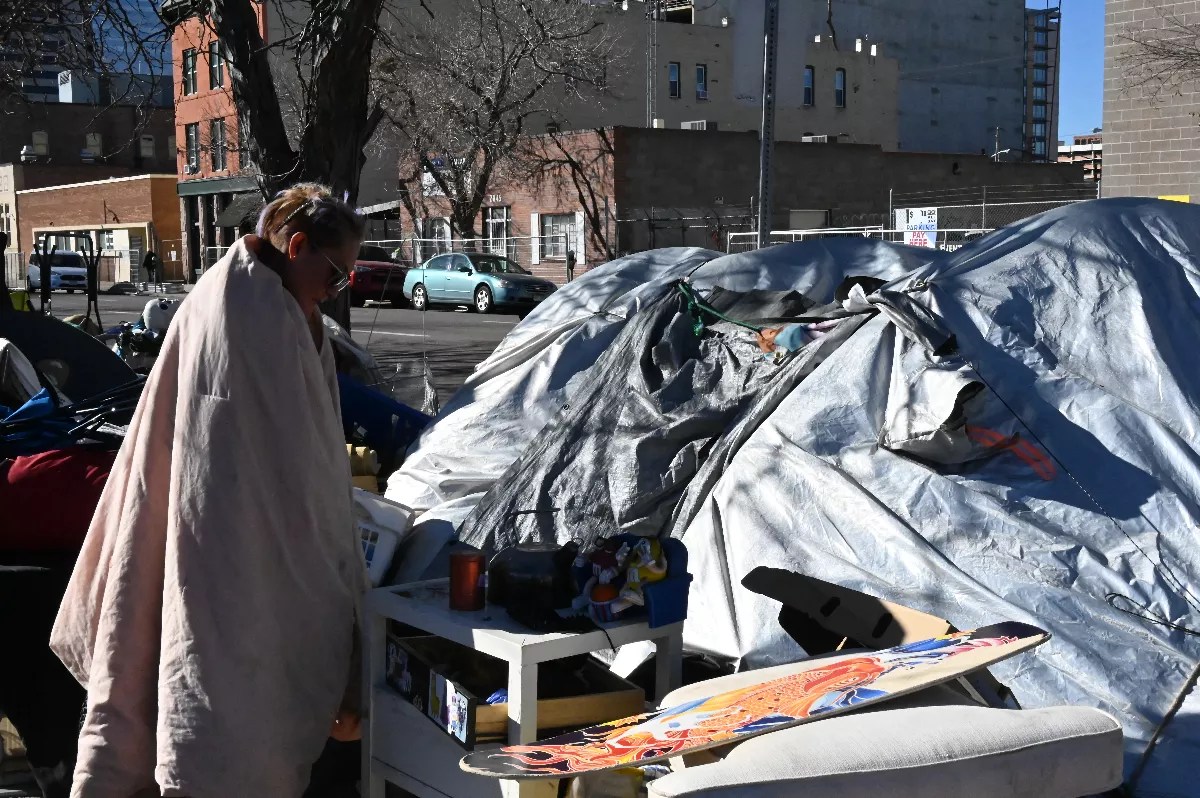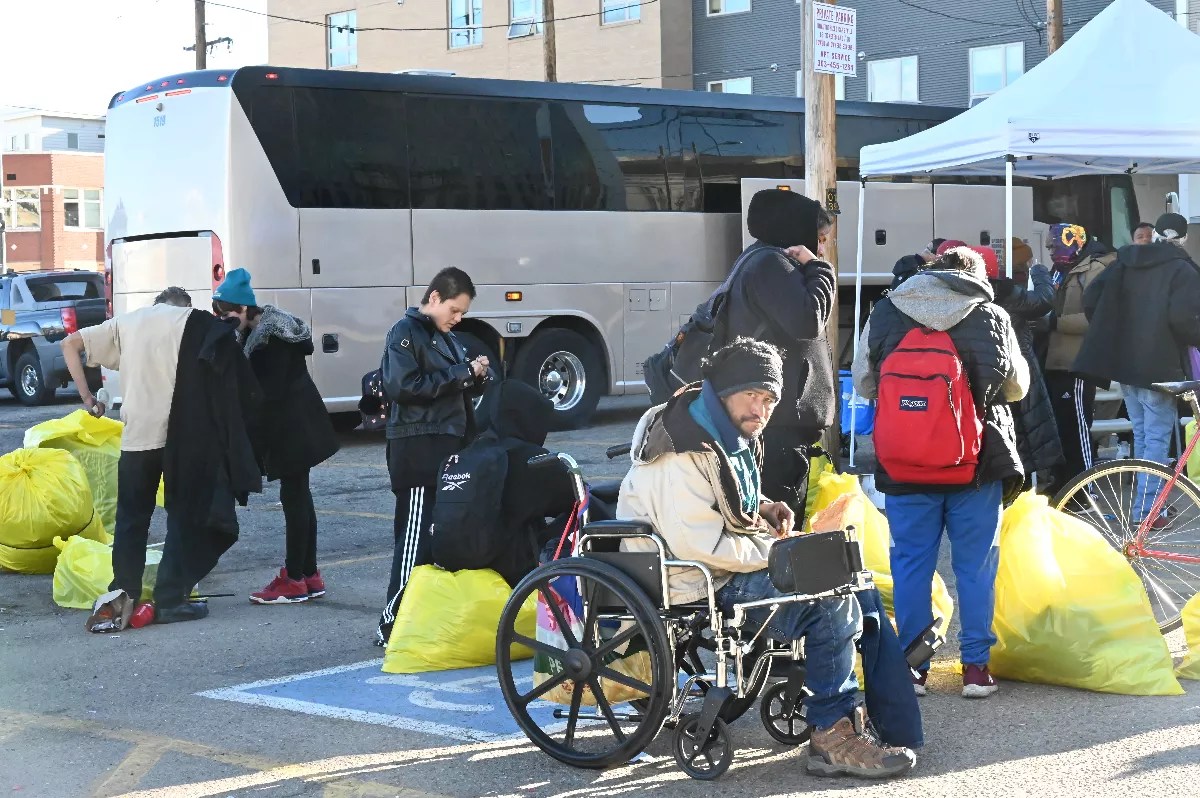
Bennito L. Kelty

Audio By Carbonatix
The first state-funded homelessness report to look at the crisis across Colorado came out on Monday, April 28, with an estimate that nearly 53,000 people are experiencing homelessness statewide.
The recommended solution sets it apart from another report published just a couple of weeks ago.
“Homelessness ends with a home,” The Colorado State of Homelessness Report 2024 urges in its call to action. “Every part of the homelessness response system – from street outreach to emergency shelter – must stay focused on connecting people to permanent housing as quickly as possible.”
Funded by the Colorado Department of Local Affairs, the new report suggests that government agencies and nonprofits continue focusing on putting people in housing, such as a temporary shelter or an apartment unit. The report was published by the Metro Denver Homeless Initiative (MDHI), a regional agency that records data on homelessness in Denver and nearby suburbs to share with the U.S. Department of Housing and Urban Development (HUD), and in collaboration with the other three regional homelessness agencies with the same role for other parts of Colorado, including El Paso County and rural and northern Colorado.
The MDHI report’s recommendations contrast with an April 17 report by the Common Sense Institute (CSI) titled “No Place to Call Home: The Stark Reality of Homelessness in Colorado,” which also focused on solutions to homelessness. A private research organization based in Greenwood Village, the CSI calls itself non-partisan but has been criticized for pushing a conservative agenda.
While MDHI wants to get homeless residents “permanent housing as quickly as possible,” the CSI suggested “a tiered system of shelter, treatment, and training to build self-sufficiency,” and cautions against providing housing “without preconditions such as sobriety, employment, or mental health treatment.”
The CSI takes issue with what’s known as a housing-first model, which prioritizes putting homeless residents under a roof and keeping them there, and Denver “embodies” that approach, according to the April 17 report. This is because Denver Mayor Mike Johnston’s first act in office was to declare homelessness a city emergency in 2023 and begin a race to house 1,000 people in six months by moving them from the street to housing units in micro-communities and former hotels.
Since 2023, the Johnston administration has moved more than 5,000 people into housing, according to the city’s newly updated All In Mile High dashboard. All In Mile High (AIMH) is the name of Johnston’s effort to tackle Denver homelessness.
Although the federally funded Point in Time count found an 11 percent reduction in homelessness in the Denver city limits from 2023 to 2024, the CSI reports that Johnston’s efforts haven’t made a “meaningful” dent.
“It is clear these policies have not meaningfully reduced the overall number of homeless individuals in the cities where they have been implemented,” according to the CSI report. “The federal, state, and local commitment to housing first policies speaks to a deep concern for the welfare and public safety of citizens. However, concern for welfare need not come in a single flavor. An effective mitigation of homelessness should produce self-sufficiency, not solely shelter.”
Instead, the CSI praised the “work-first” approach used in Aurora. Just as Denver “embodies” the housing-first model, the CSI considers Aurora “inspired” by a work-first model, which prioritizes job training and self-sufficiency for homeless residents, according to its April 17 report.
Aurora will use the work-first model to structure operations at the Aurora Regional Navigation Campus, a facility located in a former hotel near DIA that will have services for homeless residents when it opens in November. Homeless residents can stay one night at the campus, but they can stay long-term if they work with a case manager to secure a job and, if necessary, get treatment for addiction or mental health issues. In Denver’s shelters, homeless residents can stay at AIMH sites for weeks or months without securing a job.
With Aurora following the CSI and Denver in line with MDHI, the tale of these two cities will test out competing ideas for solving homelessness.

Homeless residents prepare to board a bus that will take them to transitional All In Mile High housing in Denver during Johnston’s 2023 efforts to house 1,000 people in six months.
Bennito L. Kelty
Painting Different Pictures
The CSI and MDHI both relied on the Point in Time count in their reports, but even though they start with some of the same data, the two reports go in different directions with their conclusions.
The MDHI report reached its estimate of 53,000 homeless Coloradans by looking at data from the Point in Time count, the Colorado Department of Education, and Colorado’s Homeless Management Information System, which is the database regional homeless agencies share. It found that more than half of these homeless residents have a health condition and nearly a third are chronically homeless. About 6 percent are veterans, and about 8 percent are children, according to the report.
For MDHI, the root cause of homelessness in the state is that “Colorado doesn’t have enough affordable homes,” and it recommends “addressing the root causes of homelessness, such as housing instability, low wages, and healthcare gaps.”
“To rent a two-bedroom apartment, someone would need to work 2.6 full-time jobs at minimum wage,” according to the report. “When housing costs this much while wages stay low, many people can’t keep a stable home.”
The CSI report relies on a mix of data and budgets from cities like Denver and Aurora as well as the Point in Time Count, and it focuses on how much the City of Denver has spent while comparing it to homelessness figures statewide and regionally.
Citing data from HUD, the CSI reports that homeless population in Colorado grew by 90 percent from 2020 to 2024 and in the Denver metro area by 10 percent from 2023 to 2024. The number of beds in homeless shelters statewide has nearly doubled since 2019, according to Point in Time Count data included in the CSI report.
The CSI report looks at the City of Denver’s budget to conclude that spending on homelessness more than doubled between 2023 and 2024, from $64 million to $135 million. Denver, Boulder and Aurora spent a combined $405 million on homelessness initiatives in fiscal year 2023, according to the CSI.
Despite Denver’s increased spending on homelessness, the CSI concluded in its report that “housing first policies may not be the best approach to addressing this challenge,” and to solve the problem cities should have “federal money in order to explore approaches other than housing first.“
The CSI fellow who co-wrote the April 17 homelessness report is Dustin Zvonek, a former Aurora City Councilman and vocal conservative.
“What the mayor is doing in Denver, getting them off the streets and putting them into hotels and not requiring anything of them, is just hiding homelessness,” Zvonek said during an April 17 press conference. “You’re not actually helping them.”
On the other end is Jamie Rife, executive director of the Denver Department of Housing Stability (HOST), which oversees the city’s efforts to solve homelessness, including its AIMH sites. A former advocate for the homeless at a policy level, Rife used to be the executive director of MDHI. The work that led to the Colorado State of Homelessness 2024 report began while Rife was still leading MDHI.
The biggest difference in the two reports is the recommendations for how federal money should be used. While MDHI calls for “greater investment in long-term solutions like affordable housing development,” the CSI wants local jurisdictions to have room to solve homelessness their own way.
“Federal policymakers should allow HUD to exercise flexibility with homelessness grants so that cities and states can explore different approaches,” according to the CSI report. “For example, allowing federal homelessness dollars to be distributed through flexible block grants would better empower states and municipalities to experiment with alternatives to housing first.”

Former Aurora City Councilman Dustin Zvonek now works for the Common Sense Institute, a think tank that says Aurora has a better idea for solving homelessness better than Denver.
Bennito L. Kelty
However, MDHI believes that Colorado needs “sustained investments” in affordable housing development and more funding for eviction prevention and rental assistance. The MDHI report also calls for “low-barrier shelter options,” which means temporary housing without requirements like sobriety or employment.
The CSI wants more “Denver area programs which prioritize sobriety and employment assistance,” according to its report, and argues that tracking the number of homeless residents isn’t enough. The state also needs to track how many people are “self-sufficient,” according to the CSI.
“Instead of simply tracking the number of people with roofs over their heads, policymakers and advocates should aim to determine the number of people who achieved self-sufficiency,” reads the report. “They also should examine data surrounding addiction, mental health stabilization, and employment gains.”
The CSI argues this approach will be cheaper because it gets people out of tax-funded housing sooner and keeps them off the street. It reported that Denver spent more than $69,000 per person with Johnston’s effort to house all of Denver’s homeless residents and blamed the high price tag on hundreds returning to the street after staying at an AIMH site or ending up in jail.
The city argues that the cost is closer to $29,000 per person, according to city spokesperson Jon Ewing. He adds that the CSI report “cherry picks and misrepresents data, completely ignores the rising costs of housing, and is nothing more than an absurd attempt by a conservative think tank to spread an incorrect narrative.”
Ewing believes that the MDHI report “did a good job of not being political” while the CSI report “was very political.”
Zvonek, in a statement to Westword, says he doesn’t want an Aurora-Denver duel over homelessness resolution. He says that the two cities agree on the problem that needs to be solved and says both their approaches should be tested.
“Our critique of Housing First isn’t about questioning the importance of getting people off the streets and into housing – it’s about whether we’re willing to expect more from the solutions we fund,” he says. “CSI believes both approaches deserve support.”
But in the end, he says that “outcomes – not ideology – should determine which strategies truly move the needle on this growing crisis.”